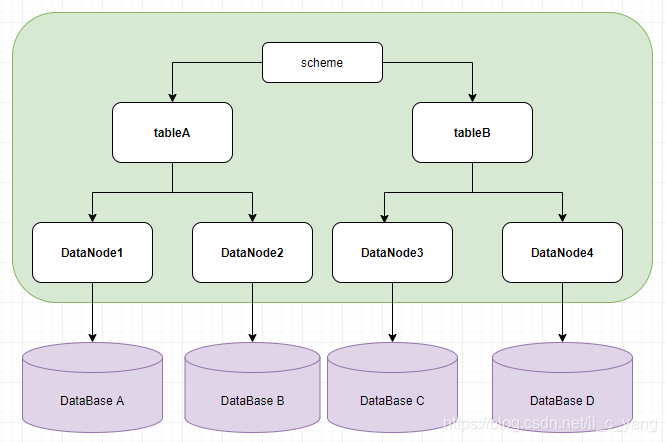Mycat介绍
Mycat架构

Mycat核心概念
- scheme: 由它指定逻辑数据库(相当于mysql的database数据库)
- Table: 逻辑表(相当于MySQL的table表)
- DataNode: 真正存储数据的物理节点
- DataHost: 存储节点所在的数据库主机(指定MySQL数据库的连接信息)
- User: MyCat的用户(类似于MySql的用户,支持多用户)
Mycat主要解决的问题
- 海量的数据存储
- 查询的优化
Mycat分片策略
MyCat支持水平分片和垂直分片
- 水平分片:一个表格的数据分割到多个节点上,按照行分割
- 垂直分片:一个数据库中多个表格A,B,C,A存储到节点1上,B存储到节点2上,C存储到节点3上


MyCat通过定义表的分片来实现分片,每个表格可以捆绑一个分片规则,每个分片规则指定一个分片字段并绑定一个函数,来实现动态分片算法
- Schema: 逻辑库,和mysql中的database对应,一个逻辑库中定义了所包含的table
- Table:表,即物理数据库中存储的某一张表,和传统的数据库不同,这里的表格需要声明称存储的逻辑数据节点DataNode。在此可以指定表的分片规则;
- DataNode: Mycat的逻辑数据节点,是存放table的集体物理节点,也称之为分片节点,通过DataHost来关联到后端的某一个数据库上
- DataHost: 定义某个物理库的访问地址,用户捆绑到Datanode上
Mycat分片
配置schema.xml
schema.xml介绍
schema.xml作为Mycat中重要的配置文件之一,管理着Mycat的逻辑库、表、分片规则、DataNode以及DataHost之间的映射关系。弄懂这些配置,是正确使用Mycat的前提。
- schema 标签用于定义MyCat实例中的逻辑库
- Table 标签定义了MyCat中的逻辑表
- dataNode 标签定义了MyCat中的数据节点,也就是我们通常说所的数据分片。
- dataHost标签在mycat逻辑库中也是作为最底层的标签存在,直接定义了具体的数据库实例、读写分离配置和心跳语句。
schema.xml配置
<?xml version="1.0"?>
<!DOCTYPE mycat:schema SYSTEM "schema.dtd">
<mycat:schema xmlns:mycat="http://io.mycat/">
<!--
schema : 逻辑库 name:逻辑库名称
sqlMaxLimit:一次取多少条数据 要超过用limit xxx
table:逻辑表
dataNode:数据节点 对应datanode标签
rule:分片规则,对应rule.xml
subTables:子表
primaryKey:分片主键 可缓存
-->
<schema name="TESTDB" checkSQLschema="false" sqlMaxLimit="100">
<!-- auto sharding by id (long) -->
<table name="item" dataNode="dn1,dn2,dn3" rule="mod-long"
primaryKey="ID"/>
</schema>
<!-- <dataNode name="dn1$0-743" dataHost="localhost1" database="db$0-743"
/> -->
<dataNode name="dn1" dataHost="localhost1" database="db1" />
<dataNode name="dn2" dataHost="localhost1" database="db2" />
<dataNode name="dn3" dataHost="localhost1" database="db3" />
<!--
dataHost : 数据主机(节点主机)
balance:1 :读写分离 0 : 读写不分离
writeType:0 第一个writeHost写, 1 随机writeHost写
dbDriver: 数据库驱动 native:MySQL JDBC:Oracle、SQLServer
switchType: 是否主动读
1、主从自动切换 -1 不切换 2 当从机延时超过slaveThreshold值时切换为主读
-->
<dataHost name="localhost1" maxCon="1000" minCon="10" balance="0"
writeType="0" dbType="mysql" dbDriver="native" switchType="1"
slaveThreshold="100">
<heartbeat>select user()</heartbeat>
<writeHost host="hostM1" url="192.168.24.129:3306" user="root"
password="root" >
</writeHost>
</dataHost>
</mycat:schema>
配置Server.xml
server.xml介绍
server.xml几乎保存了所有mycat需要的系统配置信息。最常用的是在此配置用户名、密码及权限。
server.xml配置
<?xml version="1.0" encoding="UTF-8"?>
<!DOCTYPE mycat:server SYSTEM "server.dtd">
<mycat:server xmlns:mycat="http://io.mycat/">
<system>
<property name="defaultSqlParser">druidparser</property>
</system>
<user name="mycat">
<property name="password">mycat</property>
<property name="schemas">TESTDB</property>
</user>
</mycat:server>
配置rule.xml
rule.xml介绍
rule.xml里面就定义了我们对表进行拆分所涉及到的规则定义。我们可以灵活的对表使用不同的分片算法,或者对表使用相同的算法但具体的参数不同。
这个文件里面主要有tableRule和function这两个标签。
在具体使用过程中可以按照需求添加tableRule和function。
rule.xml配置
<?xml version="1.0" encoding="UTF-8"?>
<!DOCTYPE mycat:rule SYSTEM "rule.dtd">
<mycat:rule xmlns:mycat=”http://io.mycat/“ >
//表规制定义
<tableRule name="sharding-by-intfile">
<rule>
<columns>sharding_id</columns>
<algorithm>hash-int</algorithm>
</rule>
</tableRule>
//对应分片方法定义
<function name="hash-int" class="io.mycat.route.function.PartitionByFileMap">
<property name="mapFile">partition-hash-int.txt</property>
</function>
</mycat:rule>
tableRule 标签配置说明:
- name 属性指定唯一的名字,用于标识不同的表规则
- rule 标签则指定对物理表中的哪一列进行拆分和使用什么路由算法。
- columns 内指定要拆分的列名字。
- algorithm 使用 function 标签中的 name 属性。连接表规则和具体路由算法。当然,多个表规则
可以连接到同一个路由算法上。 table 标签内使用。让逻辑表使用这个规则进行分片。
function 标签配置说明:
- name 指定算法的名字。
- class 制定路由算法具体的类名字。
- property 为具体算法需要用到的一些属性。
十个常用的分片规则
连续分片
日期列分区法
<!--按固定时间分片-->
<tableRule name="sharding-by-date">
<rule>
<columns>create_time</columns>
<algorithm>sharding-by-date</algorithm>
</rule>
</tableRule>
<function name="sharding-by-date" class="io.mycat.route.function..PartitionByDate">
<property name="dateFormat">yyyy-MM-dd</property>
<property name="sBeginDate">2014-01-01</property>
<property name="sPartionDay">10</property>
</function>
<!--按自然月分片-->
<tableRule name="sharding-by-month">
<rule>
<columns>create_time</columns>
<algorithm>sharding-by-month</algorithm>
</rule>
</tableRule>
<function name="sharding-by-month" class="io.mycat.route.function..PartitionByMonth">
<property name="dateFormat">yyyy-MM-dd</property>
<property name="sBeginDate">2014-01-01</property>
</function>
<!--按单月小时分片适合做日志,每月末,手工清理-->
<tableRule name="sharding-by-hour">
<rule>
<columns>create_time</columns>
<algorithm>sharding-by-hour</algorithm>
</rule>
</tableRule>
<function name="sharding-by-hour" class="io.mycat.route.function..LastestMonthPartition">
<property name="splitOneDay">24</property>
</function>
配置说明:
tableRule标签:
- columns :标识将要分片的表字段
- algorithm :指定分片函数
function标签:
- dateFormat :日期格式
- sBeginDate :开始日期
- sPartionDay :分区天数,即默认从开始日期算起,分隔10天一个分区
范围约定
<tableRule name="auto-sharding-long">
<rule>
<columns>user_id</columns>
<algorithm>rang-long</algorithm>
</rule>
</tableRule>
<function name="rang-long" class="io.mycat.route.function.AutoPartitionByLong">
<property name="mapFile">autopartition-long.txt</property>
</function>
配置说明:
tableRule标签:
- columns :标识将要分片的表字段
- algorithm :指定分片函数
function标签:
- mapFile :指定分片函数需要的配置文件名称
autopartition-long.txt文件内容:
# range start-end ,data node index
# K=1000,M=10000.
0-500M=0 0-100 0
500M-1000M=1 101-200 1
1000M-1500M=2 201-300 2
default=0
# 或以下写法
# 0-10000000=0
# 10000001-20000000=1
优势:扩容无需迁移数据
缺点:热点数据,并发受限
离散分片
枚举法
<tableRule name="sharding-by-intfile">
<rule>
<columns>user_id</columns>
<algorithm>hash-int</algorithm>
</rule>
</tableRule>
<function name="hash-int" class="io.mycat.route.function.PartitionByFileMap">
<property name="mapFile">partition-hash-int.txt</property>
<property name="type">0</property>
<property name="defaultNode">0</property>
</function>
配置说明:
tableRule标签:
- columns :标识将要分片的表字段
- algorithm :指定分片函数
- function标签:
- mapFile :指定分片函数需要的配置文件名称
- type :默认值为0,0表示Integer,非零表示String
- defaultNode :指定默认节点,小于0表示不设置默认节点,大于等于0表示设置默认节点,0代表节 点1。
默认节点的作用:枚举分片时,如果碰到不识别的枚举值,就让它路由到默认节点。如果不配置默认节点(defaultNode值小于0表示不配置默认节点),碰到不识别的枚举值就会报错:can’t
find datanode for sharding column:column_name val:ffffffff
partition-hash-int.txt 文件
10000=0 列等于10000 放第一个分片
10010=1
男=0
女=1
beijing=0
tianjin=1
zhanghai=2
求模法
说明: 此种配置非常明确,即根据id与count(你的结点数)进行求模运算,相比方式1,此种在批量插入时需要切换数据源,id不连续
<tableRule name="mod-long">
<rule>
<columns>user_id</columns>
<algorithm>mod-long</algorithm>
</rule>
</tableRule>
<function name="mod-long" class="io.mycat.route.function.PartitionByMod">
<!-- how many data nodes -->
<property name="count">3</property>
</function>
配置说明:
tableRule标签:
- columns :标识将要分片的表字段
- algorithm :指定分片函数
function标签:
- count :节点数量
字符串拆分hash解析
<tableRule name="sharding-by-stringhash">
<rule>
<columns>user_id</columns>
<algorithm>sharding-by-stringhash</algorithm>
</rule>
</tableRule>
<function name="sharding-by-stringhash" class="io.mycat.route.function.PartitionByString">
<property name="length">512</property> <!-- zero-based -->
<property name="count">2</property>
<property name="hashSlice">0:2</property>
</function>
配置说明:
tableRule标签:
- columns :标识将要分片的表字段
- algorithm :指定分片函数
function标签:
- length :代表字符串hash求模基数
- count :分区数
- hashSlice : hash预算位,即根据子字符串 hash运算
预算位 即根据子字符串中int值 hash运算 0 代表 str.length(), -1 代表 str.length()-1,大于0只代表数字自身,简单理解为substring(start,end),start为0则只表示0
“2” -> (0,2)
“1:2” -> (1,2)
“1:” -> (1,0)
“-1:” -> (-1,0)
“:-1” ->(0,-1)
“:” -> (0,0)
固定分片hash算法
<tableRule name="rule1">
<rule>
<columns>user_id</columns>
<algorithm>func1</algorithm>
</rule>
</tableRule>
<function name="func1" class="io.mycat.route.function.PartitionByLong">
<property name="partitionCount">2,1</property>
<property name="partitionLength">256,512</property>
</function>
配置说明:
tableRule标签:
- columns :标识将要分片的表字段
- algorithm :指定分片函数
function标签:
- partitionCount :指定分片个数列表
- partitionLength : 分片范围列表,分区长度:默认为最大2^n=1024 ,即最大支持1024分区
约束 :
count,length 两个数组的长度必须是一致的。 1024 = sum((count[i]*length[i]))
@Test
public void testPartition() {
// 本例的分区策略:希望将数据水平分成3份,前两份各占25%,第三份占50%。(故本例非均匀分区)
// |<---------------------1024------------------------>|
// |<----256--->|<----256--->|<----------512---------->|
// | partition0 | partition1 | partition2 |
// | 共2份,故count[0]=2 | 共1份,故count[1]=1 |
int[] count = new int[] { 2, 1 };
//如果需要平均分配设置:平均分为4分片,partitionCount*partitionLength=1024
//五、一致性hash
int[] length = new int[] { 256, 512 };
PartitionUtil pu = new PartitionUtil(count, length);
// 下面代码演示分别以offerId字段或memberId字段根据上述分区策略拆分的分配结果
int DEFAULT_STR_HEAD_LEN = 8; // cobar默认会配置为此值
long offerId = 12345;
String memberId = "qiushuo";
// 若根据offerId分配,partNo1将等于0,即按照上述分区策略,offerId为12345时将会被分配到partition0中
int partNo1 = pu.partition(offerId);
// 若根据memberId分配,partNo2将等于2,即按照上述分区策略,memberId为qiushuo时将会被分到partition2中
int partNo2 = pu.partition(memberId, 0, DEFAULT_STR_HEAD_LEN);
Assert.assertEquals(0, partNo1);
Assert.assertEquals(2, partNo2);
}
如果需要平均分配设置:平均分为4分片,partitionCount*partitionLength=1024
<function name="func1" class="org.opencloudb.route.function.PartitionByLong">
<property name="partitionCount">4</property>
<property name="partitionLength">256</property>
</function>
一致性hash
<tableRule name="sharding-by-murmur">
<rule>
<columns>user_id</columns>
<algorithm>murmur</algorithm>
</rule>
</tableRule>
<function name="murmur" class="io.mycat.route.function.PartitionByMurmurHash">
<!-- 默认是0 -->
<property name="seed">0</property>
<!-- 要分片的数据库节点数量,必须指定,否则没法分片 -->
<property name="count">2</property>
<!-- 一个实际的数据库节点被映射为这么多虚拟节点,默认是160倍,也就是虚拟节点数是物理节点数
的160倍 -->
<property name="virtualBucketTimes">160</property>
<!-- <property name="weightMapFile">weightMapFile</property> 节点的权重,没有指
定权重的节点默认是1。以properties文件的格式填写,以从0开始到count-1的整数值也就是节点索引为
key,以节点权重值为值。所有权重值必须是正整数,否则以1代替 -->
<!-- <property name="bucketMapPath">/etc/mycat/bucketMapPath</property>
用于测试时观察各物理节点与虚拟节点的分布情况,如果指定了这个属性,会把虚拟节点的murmur
hash值与物理节点的映射按行输出到这个文件,没有默认值,如果不指定,就不会输出任何东西 -->
</function>

一致性hash 0-2的32次方减1,预算有效解决了分布式数据的扩容问题,前1-9中id规则都多少存在数据
扩容难题,而10规则解决了数据扩容难点
编程指定
<tableRule name="sharding-by-substring">
<rule>
<columns>user_id</columns>
<algorithm>sharding-by-substring</algorithm>
</rule>
</tableRule>
<function name="sharding-by-substring" class="io.mycat.route.function.PartitionDirectBySubString">
<property name="startIndex">0</property> <!-- zero-based -->
<property name="size">2</property>
<property name="partitionCount">8</property>
<property name="defaultPartition">0</property>
</function>
配置说明:
tableRule标签:
- columns :标识将要分片的表字段
- algorithm :指定分片函数
function标签:
- startIndex :字符串截取的起始索引位置
- size :截取的位数
- partitionCount :分区数量
- defaultPartition :默认分区
11010419800101
此方法为直接根据字符子串(必须是数字)计算分区号(由应用传递参数,显式指定分区号)。
例如id=05-100000002
在此配置中代表根据id中从startIndex=0,开始,截取siz=2位数字即05,05就是获取的分区,如果没
传默认分配到defaultPartition
优点:数据分布均匀,并发能力强
缺点:移植性差、扩容性差






















 446
446











 被折叠的 条评论
为什么被折叠?
被折叠的 条评论
为什么被折叠?








